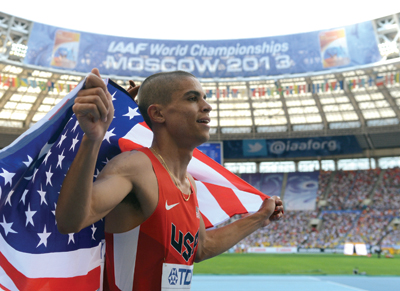Two major players in the sports industry — Nike and NBCUniversal — have made significant, decades-long investments in content they clearly value and did so at a time when many industry experts are hesitant to look much beyond 2020.
On those grounds, these organizations appear to have pushed a lot of poker chips into the middle of the table. Said another way, they went “all in” — and “all in” for a while.
The cards as we see them? Nike’s agreement to invest a reported half a billion dollars in USA Track & Field to lock up exclusive sponsorship rights until the year 2040, followed by Comcast’s NBCUniversal extending its billions-plus television (and media) rights partnership with the IOC until 2032.
It made us ask what Nike and NBC see that their competitors don’t? There must be something, right? Given the doping issues of recent years, aging track facilities (in many settings), and a general decline in youth sports participation, is it possible the original Olympic sport of 776 B.C., is actually worth nearly $500 million to Nike? And how about the decision-makers at
NBCUniversal? Do they know what they’re doing? Allegedly they bid much higher than the expected (or logical) price to make sure they continued to own the Games.
As Vince Lombardi once so famously yelled, “What the hell’s going on out here?”
Well, one of the joys of the academic lifestyle is stepping back and thinking about the future … as well as the past. And after all gets said and done, we think Nike’s leadership and the braintrust at NBCUniversal may have read their fellow card players well.
A recent article in Sport Management Review outlined how corporations need to think strategically and formulaically about sponsorship activation (Norm O’Reilly and Denyse Lafrance Horning, November 2013). That may sound elementary, but there are a number of key components to this work, with the most significant finding suggesting that vibrant partnerships happen only if activated appropriately and properly over an extended period of time.
Indeed, there is no magic number to activation (beyond that 2:1 or 3:1 spend ratio that is so often discussed), but there appear to be significant benefits to customized, context-specific, long-term approaches.
So let’s note the following: Track and field events do not have the competitive limitations of the major professional team sports at the Olympic Games. In fact, the sport has many different events with elite competitors providing significant profiles in their respective countries. Track and field also works because nearly every country of the world competes, and the cost to participate is often not much more than shoes.
 |
|
Linking itself to USATF through 2040 will give Nike visibility at events like the IAAF Worlds.
Photo by: GETTY IMAGES
|
For Nike, a global company, it’s nice that the U.S. has historically been the world’s top country in track and field. But even if the U.S. falls off, the replacement will be population-rich China.
We also note that the IAAF World Athletics Championships are by most accounts the third-largest event in the sporting world, after the Olympics and FIFA World Cup. Names like Michael Johnson, Cathy Freeman, Sergey Bubka, Sebastian Coe, Usain Bolt and many more are known worldwide.
That much makes sense. And having until 2040 is one heck of a runway to leverage or build upon that relationship.
We know that the International Olympic Committee’s TOP partners often have grabbed long-term deals (a decade or more), but this is the first time we’ve seen this (and at this scale) with a national sports organization or national governing body. But maybe Nike’s action is an “outlier” move as well as an indicator of things to come. Is it possible more companies will follow the Beaverton, Ore., giant in locking up 25-year-deals?
Why shouldn’t they?
Naming rights for stadiums have frequently gone for multiple decades. In Syracuse, the rumor is that Carrier, the air conditioning manufacturer, did an “in perpetuity” deal for the Carrier Dome (a facility that ironically has no air conditioning), and that stadium is now approaching its 35th year of operation.
That simple thought might suggest longer is better and strong associations over time build better brands.
Look at Coca-Cola’s relationship with the Olympics. Coke has been a sponsor without interruption since the 1928 Games in Amsterdam. North of the border, RBC Bank has a similar, near century-long relationship with the Canadian Olympic Committee.
In any of these cases, imagine if they had just done one deal for a short period of time. They could’ve killed it for four years and then watched a competitor swoop in to take over (or dismantle) the valuable marketing benefits that had accrued.
Maybe this boils down to the notion that if you’re planning to activate something important, then lock it up for a good long while. Granted, a sports property can have problems, but long-established sports organizations generally don’t get permanently injured, commit crimes or die. So the risk on a long-term investment is probably lower than other property-type deals, such as endorsing athletes, coaches or one-off events.
And that may be the point. If companies are risk-averse, long-term deals should flatten out the variability while providing huge influence in how things are done.
To that end, maybe Nike and NBC are only doing what Coke and RBC learned after World War I ended. That is, if you’re dealt an attractive hand (i.e., find an ideal partner with great fit), bet heavily and lock them up. The rewards of a strong partnership are easily worth the risks.
Rick Burton (rhburton@syr.edu) is the David B. Falk Professor of Sport Management at Syracuse University. Norm O’Reilly (oreillyn@ohio.edu) is the Richard P. & Joan S. Fox Professor of Management, and chair of the Department of Sports Administration at Ohio University.





